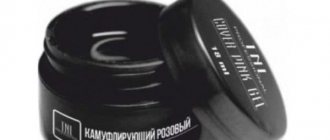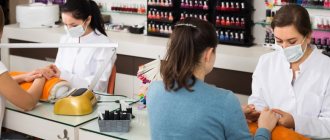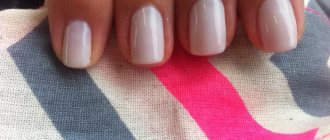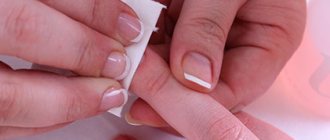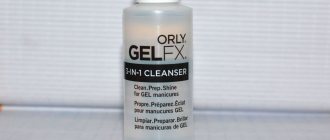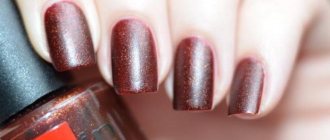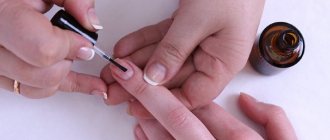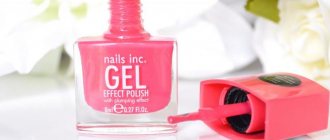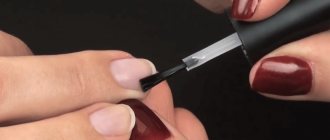Basic requirements for the adhesive composition
Nail glue is a translucent viscous liquid that is intended for manicure. It is used for several purposes:
- for repairing natural nails (broken or damaged);
- to restore extensions;
- to glue rhinestones onto the plate;
- for gluing tips.
You can use it at home, but it is better if you entrust such work to professionals. The glue has a protective effect that allows you to protect the nail plate from drying out by ultraviolet radiation. It includes:
- cyanoacrylate;
- exfoliator;
- panthenol;
- vitamin A palmitate;
- antioxidants.
The glue is non-toxic, non-flammable, and does not contain components harmful to the skin. The main substance (cyanoacrylate) is used for skin grafting. The main characteristics of the glue include viscosity, which can be of several types:
- thick, strong viscosity - does not require much time to harden;
- liquid, low viscosity - you need to hold it longer, pressing the tips to the nail.
But the second type has more opportunities for adjusting the position of the nail plate.
What you need to know when choosing
When purchasing a product, a person should understand why a fixative is needed - for primary or secondary processing
Accordingly, you should pay attention to the brush of the bottle. If it is thin, it is most likely a tool for a master
To choose the most successful product, you should pay attention to some aspects:
The fixative must not be expired. Its expiration date is usually indicated directly on the gel bottle. The packaging must not be damaged. The shelf life of an open and closed bottle is quite different. Damaged gels will not allow high-quality hair growth. The smell should not cause unpleasant sensations. Harsh and strange fragrances may indicate that low-quality materials are used for production. If the fixative is stated as black, its color must correspond to the description. If the gel is transparent, its consistency should not contain any impurities
To use the product as productively as possible, you should pay attention to the quality of the brush. The better it is, the more convenient it will likely be to use.
These simple recommendations will allow you to choose the best remedy.
Review of the best manufacturers
The popularity of extended nails is not decreasing, since thanks to modern materials they can be chosen for any look. Consumables are constantly being improved and their quality is improving. Competition between manufacturing companies contributes to the fact that the consumer becomes confident in the environmental friendliness, naturalness, health benefits, high strength and reliability of nail glue.
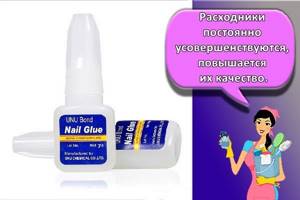
Coo-Coo-City
The nail glue package contains two components contained in plastic containers. Their contents are mixed in equal volumes, having first broken off both tips. The glue ensures good adhesion of the tips and securely attaches rhinestones, silk and other decorations. The glue does not cause harm, is non-toxic, and is strong and reliable. The volume of the product is 25 milliliters.
See also
Types of adhesives for metal and how best to glue metal at home
ORLY
The manicure set for nail repair includes:
- bottle with glue and brush - polymethylacrylate, 5 g;
- powder - quartz, acrylic polymer, 4.25 g;
- sanding block measuring 3.5 cm x 3.5 cm x 0.3 cm.
Glue can be used to easily repair a cracked or damaged nail. To do this, you need to apply glue to the plate and then immerse it in powder. The coating is polished with a sanding block after the glue has dried. To ensure a stronger adhesion, it is necessary to apply a second layer of glue and powder.
It should be remembered that drying occurs quickly (only 10 seconds).
Nail Glue
According to experts, Nail Glue is one of the best glues. It comes in a 3 ml bottle and is designed for quickly gluing artificial nails and repairing natural ones. Before using glue, it is necessary to remove fat, oil, and varnish from their surface. After this, a drop of the product is applied to the damaged area. If necessary, for better adhesion, press the gluing area with a wooden stick. After use, the spout of the container is wiped and closed with a cap.
KODI Professional
Using KODI Professional glue you can easily glue tips onto a natural nail and then give it the desired shape and length. The consistency of the product is viscous, the appearance is transparent. The bottle of glue is equipped with a brush, small and convenient. With its help, it is easy to apply glue to the nail plate without staining the skin. The product dries instantly. It has no toxic or irritating effect, is easy to use, and therefore can be used at home.
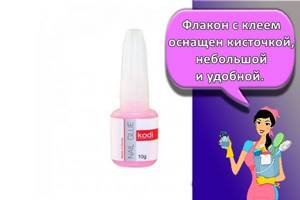
Kiss Brush On Nail Glue
Kiss Brush On Nail Glue is designed for fixing tips. It is convenient to apply, for which you need to distribute a small amount of the product over the inside of the false nail and rub it with the spout of the bottle. After this, place it on a natural one and press for a few seconds. It is necessary to avoid the appearance of air bubbles so that peeling does not occur prematurely. Excess glue is carefully removed. To remove the glued plates, use a special liquid.
RuNail
RuNaiL brand glue meets all medical standards and contains no toxic substances. The consistency of the liquid is viscous and transparent. There is no smell. Reliably glues tips to the surface of the natural nail. Adhesion, fixation and hardening occurs in just 6-8 seconds.
See also
Step-by-step instructions on how to make a phone case from hot-melt adhesive with your own hands
Types of degreasers
Degreasing the nail is a mandatory ritual before covering a natural nail with any material.
This can be done either with a single-phase liquid or with others that have additional properties - removing excess moisture from the nail, removing stickiness after polymerization of the gel, etc. Professional degreasers come in three types, each of which performs its own functions.
Dehydrator
A multifunctional product that replaces many bottles - a dehydrator. The spectrum of its action is so wide that the need to purchase other products simply disappears. But a “proper manicure” involves using the product as one of the stages of nail treatment before covering it with any artificial material. Liquid is needed for the following purposes:
- remove all contaminants from the nail, including sweat and fat deposits (but except for decorative coatings);
- disinfect the surface of the nail;
- dry (that is, dehydrate - deprive the upper layers of the nail of moisture).
Such a product does not violate the pH of the nail plate, and, if necessary, can restore it. In addition to all the above abilities, the dehydrator can be used to remove stickiness after gel coating.
It is recommended to apply the product with a brush, and distribute it evenly over the nail with a special napkin that does not leave any traces (lint, fibers, or other particles). Don’t rush and treat all your nails with a dehydrator at once. By the time the second hand gets to apply the gel (shellac, gel polish), the nails will have time to become dirty more than once. This will not only double the cost of the product, but will also result in wasted time.
Klinser
A beautiful manicure is incomplete without the use of a clinser. It is simply necessary if such compositions are used that, after polymerization, leave stickiness on top of the coating. But this product is not only characterized by the function of removing the sticky layer. It is used as a base for subsequent coating with artificial materials, which results in:
- degreasing marigold;
- elimination of other contaminants;
- antiseptic effect.
Due to the alcohol content, the cleaner can easily be used to treat not only nail plates before coating, but also manicure accessories and a drying lamp.
Essentially, this is a universal liquid that can perform all the necessary functions to create the perfect manicure. But you still shouldn’t give up the dehydrator. It is one of the mandatory stages of nail treatment before coating and nail design.
Primer
A primer is applied for a good connection (grip, adhesion) of the natural nail with almost any artificial coating. It is a “ground base” in the form of a gel-like liquid. Features of the product are:
- preventing the harmful effects of applied materials on the nail;
- removal of any “dirty” deposits;
- dry the nail plate.
Without this product it will be difficult to get a manicure for a long time. The primer opens the scales of the nail plate and settles there tightly.
Subsequent coatings no longer deal with the nail itself, but with a layer of primer; it acts as an “intermediary” between the surfaces. High-quality adhesion when coating gel polish and other materials is ensured not only by using a primer, but also by following all stages of the degreasing and nail preparation procedure.
Professional hairdressers, for example, before the extension procedure, choose a suitable primer for their client. They focus on the expected result and the condition of the nail plate. You can choose an acid-free or acidic primer. They differ from each other precisely by the presence of acid in the composition.
An acid primer-degreaser is more aggressive to both the nail and the skin surrounding it. It can cause damage to your nails if you use the product frequently. Contains methacrylic acid, so apply the primer very carefully to avoid burns.
The product thoroughly dries out all layers of the nail, which has a negative effect on it. Using an acidic agent, you can ensure more reliable adhesion of subsequent layers of coating to the natural nail. Excellent as a base before acrylic extensions.
An acid-free degreaser carefully removes excess fat and other dirt without harming the structure of the nail. After systematic use of this product, your nails will not peel or crumble. It also does not cause irritation, burning, itching, redness of the skin around the nail and other unpleasant sensations. Suitable for use before applying shellac or any gel polish.
How to properly use for gluing tips
Tips are designed for nail plate extensions. Their shape can be square, oval, vamp and stiletto, convex and flat. To glue, you need to prepare everything necessary for the procedure:
- tips of the required shape;
- orange sticks;
- files with varying degrees of abrasiveness;
- tongs for giving the tips the desired shape;
- napkins;
- base varnish;
- glue.
It must be remembered that gluing tips can only be done on healthy nails to avoid infection.
The whole process consists of several sequential steps:
- Use a file with medium dusting to treat the surface of the nail.
- Degrease its plate.
- Apply varnish.
- Apply a thin layer of glue to the tips.
- Align them with the edge of the nail and press tightly.
- Dry the glue.
- Remove its remains.
- Correct the shape of applied tips.
- They are engaged in design - coloring, gluing rhinestones, painting.
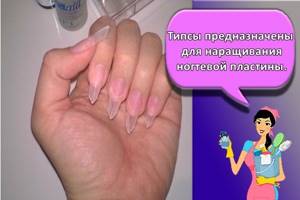
How to secure rhinestones and other decorative elements
Before you start decorating your nails with rhinestones, you should put a design template on it with holes in the places where the rhinestones should be. They are carefully taken with tweezers and placed in the holes, where a drop of glue is first applied using an orange stick. After gluing all the decorative elements, a finishing coating is applied for greater fixation.
It is more convenient to use two-component glue, since you can change the design by rearranging the stones. It does not freeze instantly and allows time for changes in the appearance of the final drawing.
Using glue to repair natural or artificial nails
Very often at home you have to repair damage to a natural or artificial nail. For repair you will need:
- glue;
- degreasing agent;
- adhesive fabric or silk;
- powder;
- buff for polishing.
To return the nail to its original state, you must:
- Wash your hands thoroughly with soap.
- Sand the nail with a buff, moving from the cuticle to the free edge.
- Degrease them.
- Place silk or fabric with an adhesive surface on the plate, covering the scrap.
- Apply a drop of glue to the damage line.
- If it gets on the skin, remove any remaining glue with a scraper or curette after drying.
- Dip your nail into the powder.
- After 5 minutes, remove the powder with a brush and apply glue again.
- After drying, polish the surface until perfectly smooth.
See also
Technical characteristics of Yunis 2000 glue and instructions for use
Analogue version of the clinser – dehydrator
Having dealt with the question of what a clinser is, let's take a closer look at its most common analogue - a nail dehydrator. Undoubtedly, many have heard about it, and perhaps this is what you use to degrease the nail plate and remove the dispersion layer. Perhaps someone will even decide that these are again different names for the same product. And someone, reading the previous section, will decide that they are missing an important point in manicure by using a dehydrator and forgetting about the cleanser.
Both are wrong. Yes, a dehydrator and a cleanser have similar functions, properties and purposes, but they are completely different means. Thus, the cleanser acts more gently and removes only the natural fat layer from the nail plate. A dehydrator, in addition to removing the fat layer, removes excess water from the nail plate, penetrating deep into the nail. Thus, the dehydrator provides more reliable adhesion to the nail plate.
Interesting
Despite the fact that the dehydrator dries out the nail plate, it is the most gentle product among the group of degreasers. Its main active ingredient, butyl acetate, evaporates very quickly. After using the dehydrator, the pH balance is restored in the shortest possible time. In addition, once it gets on the skin, it does not cause irritation or allergic reactions.
Naturally, everyone must decide for themselves which product they will use to prepare their nails for applying gel polish. You just need to indicate in what cases it would be more appropriate to use one or another degreasing solution.
- If you have “wet” nails, then a dehydrator is your option. How to determine the “wetness” of nails? Only by experience. You may have noticed that you or your friends' manicures, done according to all the rules, begin to come off after just a couple of days, while for others it lasts for weeks. And so time after time. All this means that your nails are too wet. It is in your case that a dehydrator is the best option.
- If, on the contrary, you have excessively dry nails, then a dehydrator is contraindicated for you, because it will dry them out even more. You can also “identify” a dry nail plate experimentally. As a rule, after applying a dehydrator, the free edge of “dry” nail plates curls into a kind of cone. It is in this case that only a clinser should be used.
What to use at the final stage is no longer so important, and the cleanser and dehydrator do an excellent job of removing the sticky layer and providing a glossy shine to the manicure.
How to remove residue from nail plates
It is not difficult to remove tips and overlays without damaging your nail plate. It is more difficult to remove the remnants of the glue with which they were attached. For this procedure you will need:
- nail polish remover with acetone;
- nail remover;
- cotton pads;
- hand cream;
- hot water;
- foil;
- manicure sticks.
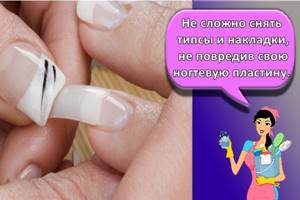
It is worth performing a number of sequential actions:
- Place a few drops of nail remover under each plate.
- Lift and remove the pads using an orange stick.
- Polish the areas with glue.
- Place your hands and a bottle of nail polish remover in hot water.
- Apply the heated product onto a cotton pad and apply to your nails.
- Wrap each finger in foil for 20 minutes.
- Clean the adhesive with a disc and rinse with water.
- Treat with moisturizer.
How to glue nails if there is no glue
If you run out of the glue that came with the kit, or it got lost, then you can find a way out of this situation. But there is a nuance: you cannot use adhesives that are not intended for this purpose. It is better to purchase it in a special store. If you don’t have time to go to it, then you can use transparent varnish; it will replace good glue for false nails.
First, you need to degrease the nail, then apply varnish and glue an artificial tip. After this, you need to hold it for several minutes, pressing it with your fingers onto the natural nail. This method is not very reliable. But according to many women, when using varnish, you can be sure that the nail plate will not be damaged; this method is considered safe.
What can be replaced
It is better to fix artificial nails with special glue. We can assume that there is no alternative to it. Fastening with PVA or BF-6 is unreliable. Superglue can seriously damage your nail plates. Even if you managed to fix the false nails at first, there is no guarantee that after a while they will not unexpectedly get lost.
When buying manicure products, you should take care of purchasing a well-known brand of glue to not only ensure reliable fixation, but also the health of your nails.
Pros and cons of false nails
There are both positive and negative aspects to false nails. Let's first consider the pros:
- they largely hide the imperfections of the nail plate, all irregularities become invisible;
- they can be painted in any color, varnish adheres to them very well, the smooth surface allows you to make any designs without streaks;
- difficult to break, unlike real nails;
- false nails are made of such a material that the varnish on them looks richer and brighter;
- The material from which the tips are made includes components that are safe for health.
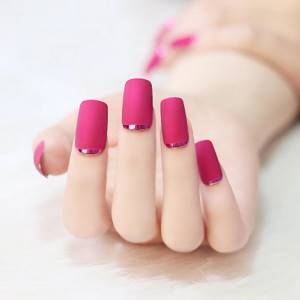
But there are also negative points:
- glue for false nails sticks firmly to the plate, and after removing them destroys the top layer of the natural nail;
- the gluing procedure itself must be done by a professional, otherwise the nail plate can be damaged;
- After this procedure, fungal diseases may appear.

